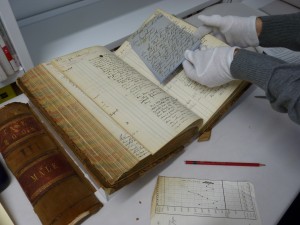As our project team continues to clean and prepare for use the case books of Stirling District Asylum we are discovering a wealth of additional information in the enclosures which are pinned, fastened or interleaved throughout the volumes. The case notes written in the pages of the case books record the initial personal and medical information collected at the time of admission and go on to provide regular updates on the treatment and condition of patients during their stay in the asylum. The enclosures, which are being carefully removed and catalogued, provide further medical and personal information relating to the patients.

Detailed accounts of the condition and behaviour of patients prior to admission are recorded in official correspondence from doctors, parish councils and other asylums from which patients have been transferred. Extracts from the medical certificates which were completed prior to admission are also sometimes included. Occasionally the incidents that triggered admission to the asylum were reported in the local press and press cuttings of such events were often placed alongside the case notes. Evidence of the care and treatment of the patients can be seen in the various hospital forms and records which are present including temperature charts, eye-test forms and additional loose case notes.
Alongside these official records the case books also include the personal correspondence of the patients themselves, an additional layer of evidence which brings their stories alive. The letters written by patients were intended for family and friends but these handwritten messages never left the asylum, instead being added by the hospital authorities to the case notes as evidence of the patient’s state of mind. Indeed some of these letters provide vivid first-hand accounts of the delusions and hallucinations suffered by patients. Many write of being kidnapped and held against their will, or ask for help to escape their incarceration. Other letters, however, are more measured and considered, apologizing to parents or spouses for their recent behaviour and asking loved ones to come and visit.
It is heartening to note that not all patient correspondence was confined within the walls of the asylum. The enclosures also include the occasional letter written by a recovered patient to the doctors in the asylum thanking them for their treatment and providing an account of life since their return home.